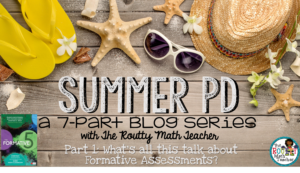
I’m so exciting to begin my 2017 Summer PD series with you today! When I attended the NCTM (National Council of Teachers of Mathematics) annual conference this past April, one of the bestselling books was a new book called The Formative 5 by Skip Fennell, Beth Kobett, and Johnathan Wray, which offers teachers five everyday assessment techniques to inform your planning and instruction. Through the Summer PD series, I will be discussing each of the techniques and offering ways to get started using them in school next August. You can even catch a video summarizing the week’s learning over on Facebook or my YouTube Channel. Ready? Let’s dive right in!
[youtube https://www.youtube.com/watch?v=xVvGdT_JsHM]
Don’t see the video? Click here to see the video version of this post!
What is a Formative Assessment?
Assessing what our students know and are able to do is part of what we do as educators each and every day; however, the type of assessment we use differs from day to day. Sometimes, we want to assess our students’ understanding of the last unit or set of skills. In this case, we use a summative assessment—a tool that will allow us to assess students’ overall understanding of content and skills. A summative assessment can be a unit or chapter test, district-created benchmark test, high-stakes test, etc. Summative test results are often used to determine classroom or grade-level interventions.
On the other hand, formative assessments tend to be more fluid and vary widely. Formative assessments provide evidence and information that is used as feedback to make changes to the teaching and learning process. A formative assessment, sometimes referred to as assessment for learning, can be anything that will provide the necessary information to inform the instructional practices of teachers.
